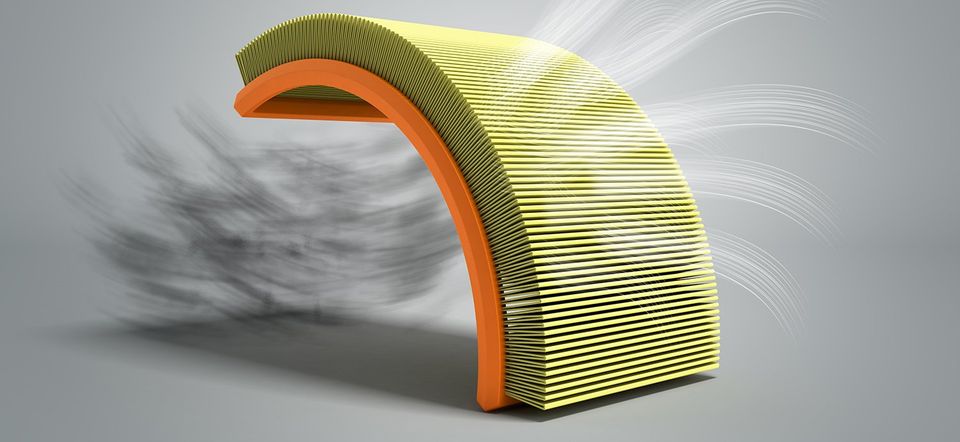CABIN AIR FILTERS
It is now common place to hear weather reports that include the “current air quality” based on pollution index or “smog days”. These smog days are becoming more frequent and are impacting our respiratory systems. The air we breathe is contaminated with pollen, mold spores, pollution etc. and can cause respiratory irritation and discomfort, especially in the very young, elderly and those with pre-existing respiratory conditions.
Another contributing factor that has increased the severity high “pollen index days” is the banning of weed control chemicals and pesticides by municipalities and provinces that were used to control the allergen producing weeds that have been proven detrimental to allergy sufferers.
Improving our air quality will take many years, but for now we can certainly improve the air we breathe in our vehicles. That is why understanding and maintaining your cabin air filtration system is so essential. (continued below)

What is a Cabin Air Filter?
A cabin air filter is often confused with the vehicles engine air filter. The vehicles engine air filter filters the air entering the engine, while the cabin air filter traps and removes contaminates from the ambient air entering your vehicles passenger seating area.
The filter is a component in the vehicles ventilation system and is used during the ventilation, heating and cooling of the passenger compartment.
The filter is designed to remove airborne particles such as dust, mold spores, bacteria, pollen, smog and more, much the same as your home furnace air filter, works to clean the air circulating throughout your home. As air enters into your vehicle through its ventilation system it must pass through the filter.
The removal of such contaminants not only improves the air you breathe, but also aids in keeping the vehicle interior cleaner with less dust accumulation.
Cabin Air Filter Construction
Cabin Air Filters are constructed using a nonwoven, triple-layered, micro fiber filter media. Each layer is progressively denser. As such, each layer traps different size particles. The media also incorporates an electrostatic filtration of particles as small as one micron in diameter. As a reference the human hair measures 50 to 70 microns in diameter. If these micro particles were to remain unfiltered, they would cause respiratory irritation for those with or even without allergies.
There are two types of Cabin Air Filters used in passenger vehicles: Particulate and Carbon. Both utilize the filter media described above but have a few notable differences. Particulate Cabin filters are the most common and can be identified by their bright white coloured media. Carbon Cabin Air Filters (also known as “Combination Filters) have a dark grey filter media. This filter media has activated charcoal incorporated within the filter media. The charcoal is “activated” charcoal incorporated within the filter media. The charcoal is “activated” using a process that involves chemicals and heat. Theses darker filters are less efficient than the particulate filters due to the addition of the activated charcoal. This addition requires a reduction in filter surface area in order to maintain adequate air flow in filters of similar size. The benefit of activated charcoal is the odour protection. These filters not only filter micro particles, but also filter gaseous pollutants as well. Although initially reserved for high end vehicles, they are becoming increasingly more common.
When to replace a Cabin Air Filter
The filtering capability of the Cabin Air Filter is far superior to that of an Engine Air Filter, therefore; it will trap more contaminants sooner. As such, a vehicles Cabin Air Filter will usually require replacement before the vehicles Engine Air Filter is due. This is a simple and efficient courtesy inspection performed by our service technicians, which can easily determine the condition of your Cabin Air Filter.
- Utilizing a manufacturer database for your specific make and model, we will follow your vehicles manufacturer replacement interval. That interval is a great guideline to follow, however; depending on the environment you typically travel e.g. if you live near a construction zone, farm land, the beach or unmaintained roads, you will need to replace your filter more often as contamination will clog a filter much sooner than the manufacturer recommends.
- Secondly our service technicians will perform a Visual inspection of the filter.
This is truly the best way to determine if you need a filter replacement.
Some of the signs of an expired Cabin Air Filter are:
- Excessive dust, soot, grime and dirt.
- Foreign objects which may range from a dead mouse, a nest, twigs, insects, or leaves. None of those things belong on your air filter or in the filter compartment. This will certainly add extra load to the circulating blower motor and may cause an early retirement. A costly repair that can be avoided with proper maintenance of your Cabin Air Filter.
Today we spend more time in our vehicles than ever before. Why compromise your comfort or your passengers. Check your vehicle owners manual for specific servicing intervals or ask our service team the next time your vehicle requires service.

